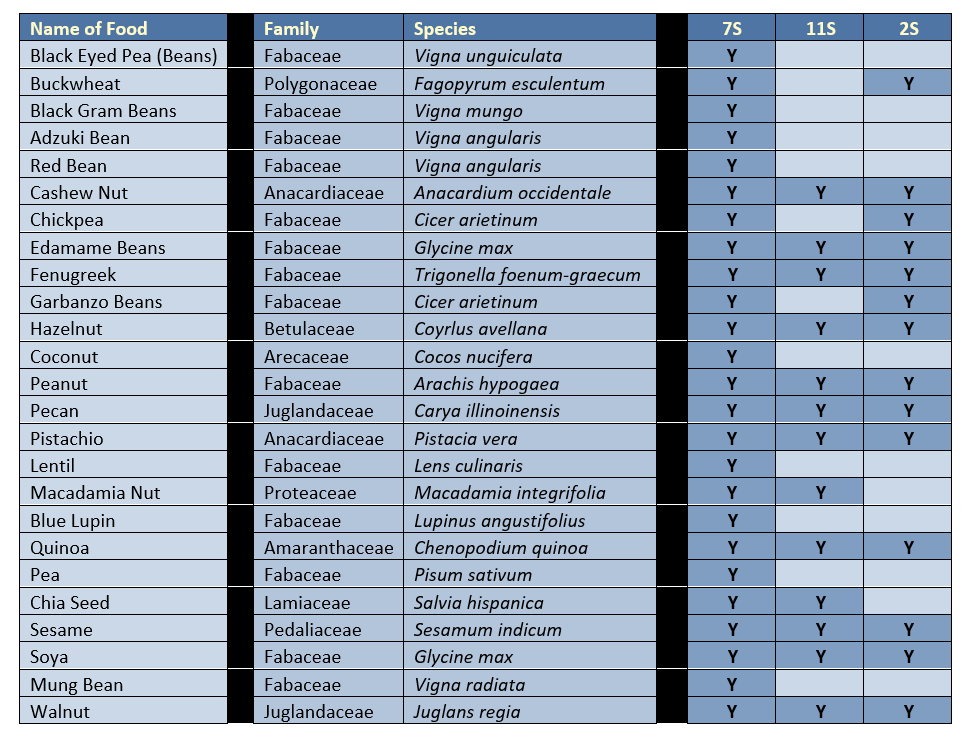
7S Seed Storage Proteins
This is simplified information about 7S seed storage proteins – there are more resources available at the bottom of the page for further reading for those who are interested in knowing more.
They are globulin proteins involved in the hydration processes in plant cells and are important for breakdown during germination.
7S seed storage proteins belong to the cupin superfamily which include a wide range of enzymes as well as 7S and 11S seed storage proteins.
Fruits and vegetables containing these proteins are coconut, mung beans and peas.
7S seed storage proteins are also found in buckwheat, quinoa, amaranth, chia seeds, fenugreek, hemp, chickpea and lentils.
7S refers to the sedimentation co-efficient of the protein (a measure of how quickly the protein sediments in a centrifuge). These three proteins look similar but they have differing chemical compositions.

You can download a Seed Storage Protein Factsheet from the Allergy Resources Ko-fi Shop for just $0.90 (£0.69 or €0.82). This has up to date information on which foods contain linked allergens and what to avoid if you think you are allergic to seed storage proteins.
What are 7S seed storage proteins?
7S seed storage proteins are also known as vicilin and these terms are often used interchangeably.They are globulin proteins involved in the hydration processes in plant cells and are important for breakdown during germination.
7S seed storage proteins belong to the cupin superfamily which include a wide range of enzymes as well as 7S and 11S seed storage proteins.
What foods are 7S seed storage proteins found in?
In the top 14 foods, peanuts, cashews, pecan, hazelnut, soya beans, walnut, pistachio, macadamia nuts, sesame and lupin all contain 7S seed storage proteins.Fruits and vegetables containing these proteins are coconut, mung beans and peas.
7S seed storage proteins are also found in buckwheat, quinoa, amaranth, chia seeds, fenugreek, hemp, chickpea and lentils.
What symptoms can 7S seed storage proteins cause?
Allergy to foods containing 7S seed storage proteins have a wide range of symptoms and severity including urticaria (hives or welts), angioedema (swelling under the skin), nausea, abdominal pain, vomiting or breathlessness and anaphylactic shock.Are 7S seed storage proteins different from 2S and 11S seed storage proteins?
Many of the foods containing 7S seed storage proteins will also contain 2S and 11S seed storage proteins. 7S and 11S seed storage proteins are globulins and 2S seed storage proteins are albumins. Globulins are storage proteins found most often in legumes and albumins are water soluble proteins found more often in nuts and seeds.7S refers to the sedimentation co-efficient of the protein (a measure of how quickly the protein sediments in a centrifuge). These three proteins look similar but they have differing chemical compositions.
A Table of Cross Reactivity between 2S, 7S and 11S seed storage proteins

You can download a Seed Storage Protein Factsheet from the Allergy Resources Ko-fi Shop for just $0.90 (£0.69 or €0.82). This has up to date information on which foods contain linked allergens and what to avoid if you think you are allergic to seed storage proteins.
How Cross Reactive are 7S albumin proteins?
7S seed storage proteins in many foods all look very similar, but it is not guaranteed that an allergy to one food will result in cross reactivity with another.Websites
Science Direct – Cupin Superfamily
Science Direct – Vicilin
Science Direct – What are Storage Proteins?
Science Direct – Vicilin
Science Direct – What are Storage Proteins?
Articles and Journals
Cottonseed Vicilin Proteins: Potential Allergen Risk and Source of Bioactive Peptides, 2025
Research progress in soybean lipophilic protein (LP): Extraction, structural, techno-functional properties, and high-performance food applications, 2024
Hemp seed: An allergen source with potential cross-reactivity to hazelnut, 2023
Seed Storage Protein, Functional Diversity and Association with Allergy, 2023
Physicochemical and Functional Properties of 2S, 7S, and 11S Enriched Hemp Seed Protein Fractions, 2022
Lentil allergens identification and quantification: An update from omics perspective, 2022
Fruit allergies: Beware of the seed allergens! 2018
Vicilin and the basic subunit of legumin are putative chickpea allergens, 2013
Seed storage proteins of the globulin family are cleaved post-translationally in wheat embryos, 2012
Optimization of extraction and isolation for 11S and 7S globulins of soybean seed storage protein, 2007
Vicilin and convicilin are potential major allergens from pea, 2004
Patients with anaphylaxis to pea can have peanut allergy caused by cross-reactive IgE to vicilin (Ara h 1), 2003
Ana o 1, a cashew (Anacardium occidental) allergen of the vicilin seed storage protein family, 2002
Vicilins: A case study in allergen pedigrees, 2002
Research progress in soybean lipophilic protein (LP): Extraction, structural, techno-functional properties, and high-performance food applications, 2024
Hemp seed: An allergen source with potential cross-reactivity to hazelnut, 2023
Seed Storage Protein, Functional Diversity and Association with Allergy, 2023
Physicochemical and Functional Properties of 2S, 7S, and 11S Enriched Hemp Seed Protein Fractions, 2022
Lentil allergens identification and quantification: An update from omics perspective, 2022
Fruit allergies: Beware of the seed allergens! 2018
Vicilin and the basic subunit of legumin are putative chickpea allergens, 2013
Seed storage proteins of the globulin family are cleaved post-translationally in wheat embryos, 2012
Optimization of extraction and isolation for 11S and 7S globulins of soybean seed storage protein, 2007
Vicilin and convicilin are potential major allergens from pea, 2004
Patients with anaphylaxis to pea can have peanut allergy caused by cross-reactive IgE to vicilin (Ara h 1), 2003
Ana o 1, a cashew (Anacardium occidental) allergen of the vicilin seed storage protein family, 2002
Vicilins: A case study in allergen pedigrees, 2002
Let me know if you found any of these interesting or useful.
If you spot an article or research that you think is interesting you can message me or tag me on Facebook or Twitter - links at the bottom of the page.